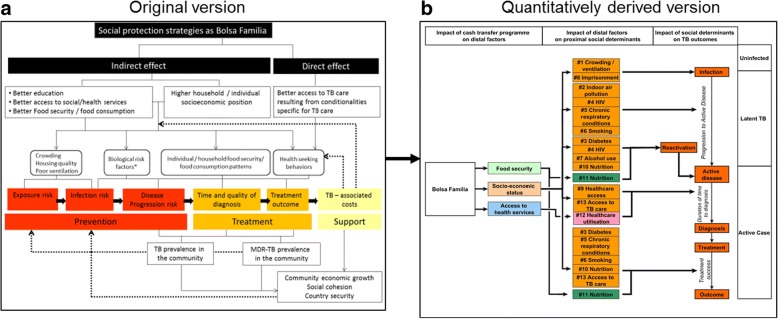Fig. 1.
Conceptual framework: the original version and the quantitative translation into 13 separate pathways. In its original version (Fig. 1a) this framework assumes that social protection interventions such as the Bolsa Familia Programme can improve TB outcomes either indirectly by influencing the distal/structural social determinants of TB (e.g., living conditions, food security), or directly by making support conditional on health-seeking behaviours relevant for TB (e.g. TB testing and preventive therapy among household contacts, TB treatment completion, BCG vaccination in children). Indirect effects on distal social determinants can alter a number of proximal mediators (e.g., indoor air pollution, malnutrition, co-morbidities) known to be associated with TB infection, progression, disease severity, or TB outcomes (including economic impact, albeit this was not accounted for in this initial modelling effort). To the extent that these associations are causal, and depending of the population targeted, reducing the prevalence of these mediators should improve TB outcomes accordingly. Fig 1b represents graphically the quantitatively derived version of this framework outlining the 13 pathways that were prioritised and extracted specifically for Bolsa Familia in Brazil. As explained in the text, three levels of impact can be identified (outlined at the top of figure: 1) the impact of social protection on distal factors (e.g. household socioeconomic position); 2) the impact of distal factors on more proximal social determinants of TB (i.e. listed from 1 to 13 depending on the specific pathway); and 3) the impact of these factors on TB outcomes (e.g. infection or disease). When social protection schemes are developed to have direct effects on TB outcomes themselves (e.g. in TB-specific interventions),(HYPERLINK "" \l "_ENREF_17" \o "Boccia, 2016 #1990" 17) the first two levels (1 and 2) can be bypassed; however, in the much more common situation where social protection is designed at programmatic level (like BFP) to improve the distal structural determinants of health, all three levels must be considered

